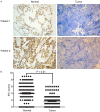The downregulation of Bcl-xL/Bcl-2-associated death promoter indicates worse outcomes in patients with small cell lung carcinoma
- PMID: 26722503
- PMCID: PMC4680448
The downregulation of Bcl-xL/Bcl-2-associated death promoter indicates worse outcomes in patients with small cell lung carcinoma
Abstract
It is well known that lung cancer is the 1st leading cause of death worldwide. Many reports have demonstrated that Bad, the Bcl-xL/Bcl-2-associated death promoter plays a crucial role in the intrinsic apoptosis pathway. The aim of this study was to explore the expression of Bad and its clinical significance in small cell lung carcinoma (SCLC) By analyzing the expression of Bad in 147 SCLC patient specimen, we found that Bad expression was remarkably decreased in 55.8% (82/147) cases, compared with the neighboring non-tumor tissues. Further study showed that Bad expression was correlated with adverse clinical characters such as clinical stage (P = 0.001), tumor size (P = 0.036) and tumor recurrence (P = 0.030). Furthermore, the results of Kaplan-Meier analysis showed that low Bad expression was significantly correlated to overall survival (P < 0.0001) and disease-free survival (P = 0.017) of patients with SCLC. Moreover, multivariate analyses revealed that Bad was an independent indicator of overall survival in SCLC (hazard ration = 0.620, 95% confidence interval: 0.389-0.987, P < 0.001). In summary, we can conclude that patients with SCLC represent downregulation of Bad and the latter could be served as a useful biomarker for the outcomes of SCLC.
Keywords: Bad; Bcl2; SCLC; poor prognosis.
Figures



Similar articles
-
Loss of Bad expression confers poor prognosis in non-small cell lung cancer.Med Oncol. 2012 Sep;29(3):1648-55. doi: 10.1007/s12032-011-0060-4. Epub 2011 Sep 15. Med Oncol. 2012. PMID: 21918885
-
High expression of oncoprotein DEK predicts poor prognosis of small cell lung cancer.Int J Clin Exp Pathol. 2014 Jul 15;7(8):5016-23. eCollection 2014. Int J Clin Exp Pathol. 2014. PMID: 25197373 Free PMC article.
-
NAD(P)H:quinone oxidoreductase-1 overexpression predicts poor prognosis in small cell lung cancer.Oncol Rep. 2014 Dec;32(6):2589-95. doi: 10.3892/or.2014.3494. Epub 2014 Sep 17. Oncol Rep. 2014. PMID: 25231218
-
Clinical significance of NQO1 polymorphism and expression of p53, SOD2, PARP1 in limited-stage small cell lung cancer.Int J Clin Exp Pathol. 2014 Sep 15;7(10):6743-51. eCollection 2014. Int J Clin Exp Pathol. 2014. PMID: 25400754 Free PMC article.
-
Abnormal expression of LCA and CD43 in SCLC: a rare case report and brief literature review.BMC Pulm Med. 2024 Apr 22;24(1):195. doi: 10.1186/s12890-024-03005-w. BMC Pulm Med. 2024. PMID: 38649942 Free PMC article. Review.
Cited by
-
Emerging role of BAD and DAD1 as potential targets and biomarkers in cancer.Oncol Lett. 2021 Dec;22(6):811. doi: 10.3892/ol.2021.13072. Epub 2021 Sep 28. Oncol Lett. 2021. PMID: 34671425 Free PMC article. Review.
-
HIV Nef-mediated Ubiquitination of BCL2: Implications in Autophagy and Apoptosis.Front Immunol. 2021 May 6;12:682624. doi: 10.3389/fimmu.2021.682624. eCollection 2021. Front Immunol. 2021. PMID: 34025682 Free PMC article.
-
Non-canonical BAD activity regulates breast cancer cell and tumor growth via 14-3-3 binding and mitochondrial metabolism.Oncogene. 2019 May;38(18):3325-3339. doi: 10.1038/s41388-018-0673-6. Epub 2019 Jan 11. Oncogene. 2019. PMID: 30635657 Free PMC article.
-
Survivin Regulates Bad Gene Expression by Binding to Its Promoter and Modulates Cell Cycle and Apoptosis in Esophageal Carcinoma Cell.J Oncol. 2021 Jan 5;2021:1384289. doi: 10.1155/2021/1384289. eCollection 2021. J Oncol. 2021. PMID: 33488710 Free PMC article.
-
New link between RNH1 and E2F1: regulates the development of lung adenocarcinoma.BMC Cancer. 2024 May 24;24(1):635. doi: 10.1186/s12885-024-12392-6. BMC Cancer. 2024. PMID: 38783241 Free PMC article.
References
-
- Torre LA, Bray F, Siegel RL, Ferlay J, Lortet-Tieulent J, Jemal A. Global cancer statistics, 2012. CA Cancer J Clin. 2015;65:87–108. - PubMed
-
- Planchard D, Le Pechoux C. Small cell lung cancer: new clinical recommendations and current status of biomarker assessment. Eur J Cancer. 2011;47(Suppl 3):S272–283. - PubMed
-
- Rossi A, Di Maio M, Chiodini P, Rudd RM, Okamoto H, Skarlos DV, Fruh M, Qian W, Tamura T, Samantas E, Shibata T, Perrone F, Gallo C, Gridelli C, Martelli O, Lee SM. Carboplatin- or cisplatin-based chemotherapy in first-line treatment of small-cell lung cancer: the COCIS meta-analysis of individual patient data. J. Clin. Oncol. 2012;30:1692–1698. - PubMed
-
- Fruh M, De Ruysscher D, Popat S, Crino L, Peters S, Felip E. Small-cell lung cancer (SCLC): ESMO Clinical Practice Guidelines for diagnosis, treatment and follow-up. Ann Oncol. 2013;24(Suppl 6):vi99–105. - PubMed
-
- Sher T, Dy GK, Adjei AA. Small cell lung cancer. Mayo Clin Proc. 2008;83:355–367. - PubMed
Publication types
MeSH terms
Substances
LinkOut - more resources
Full Text Sources
Medical
Research Materials
